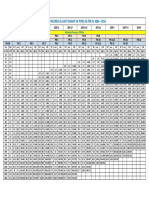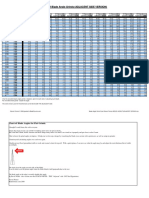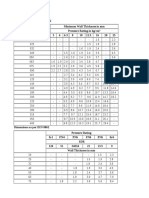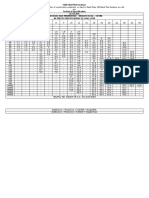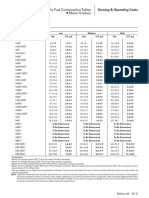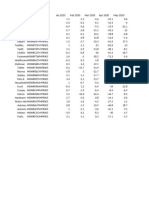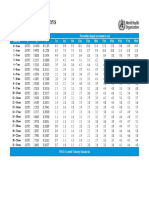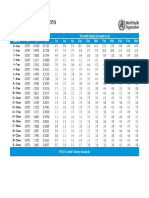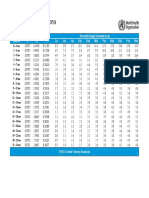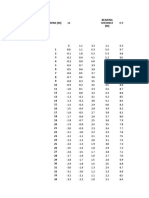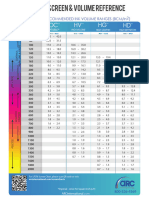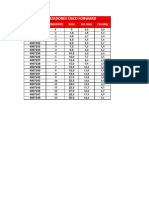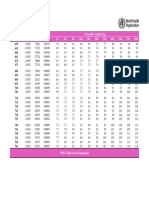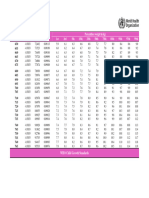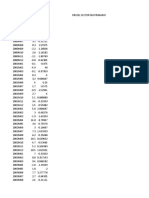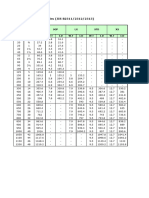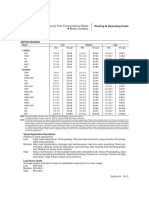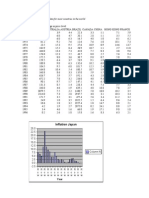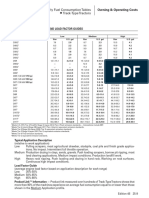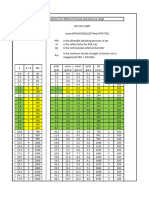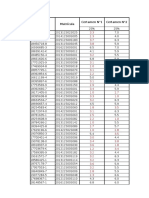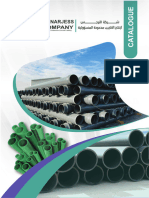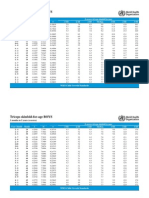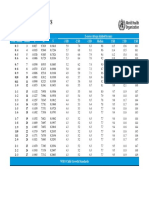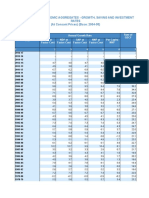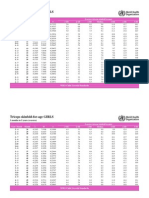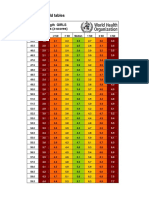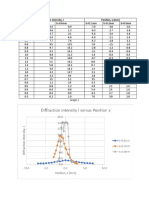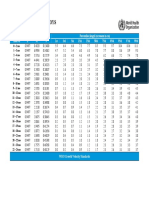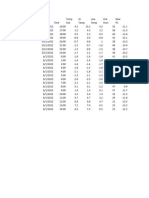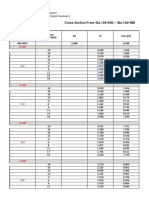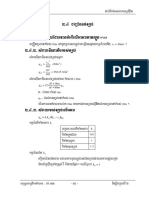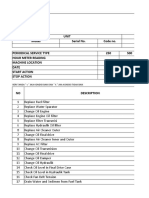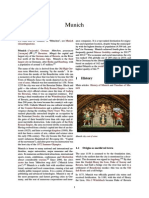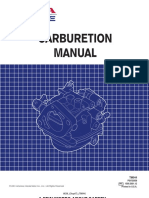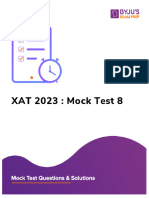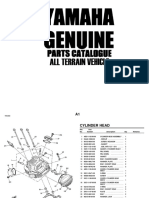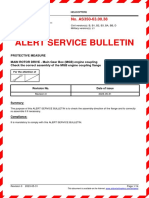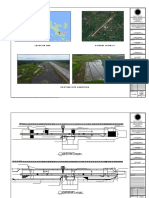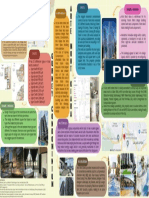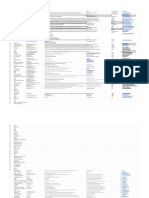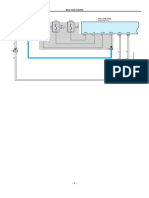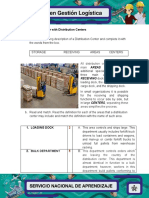0 ratings0% found this document useful (0 votes)
106 viewsHourly Fuel Consumption Tables Wheel Loaders and Integrated Toolcarriers
Hourly Fuel Consumption Tables Wheel Loaders and Integrated Toolcarriers
Uploaded by
phannaThe document provides hourly fuel consumption rates for various wheel loader and integrated toolcarrier models in three levels of operation: low, medium, and high. It lists the fuel consumption rates in liters and U.S. gallons for each machine model under each level of operation. It also provides brief descriptions of typical applications that would constitute low, medium, and high operation.
Copyright:
© All Rights Reserved
Available Formats
Download as PDF, TXT or read online from Scribd
Hourly Fuel Consumption Tables Wheel Loaders and Integrated Toolcarriers
Hourly Fuel Consumption Tables Wheel Loaders and Integrated Toolcarriers
Uploaded by
phanna0 ratings0% found this document useful (0 votes)
106 views2 pagesThe document provides hourly fuel consumption rates for various wheel loader and integrated toolcarrier models in three levels of operation: low, medium, and high. It lists the fuel consumption rates in liters and U.S. gallons for each machine model under each level of operation. It also provides brief descriptions of typical applications that would constitute low, medium, and high operation.
Original Title
Fuel+Table+-+Loaders
Copyright
© © All Rights Reserved
Available Formats
PDF, TXT or read online from Scribd
Share this document
Did you find this document useful?
Is this content inappropriate?
The document provides hourly fuel consumption rates for various wheel loader and integrated toolcarrier models in three levels of operation: low, medium, and high. It lists the fuel consumption rates in liters and U.S. gallons for each machine model under each level of operation. It also provides brief descriptions of typical applications that would constitute low, medium, and high operation.
Copyright:
© All Rights Reserved
Available Formats
Download as PDF, TXT or read online from Scribd
Download as pdf or txt
0 ratings0% found this document useful (0 votes)
106 views2 pagesHourly Fuel Consumption Tables Wheel Loaders and Integrated Toolcarriers
Hourly Fuel Consumption Tables Wheel Loaders and Integrated Toolcarriers
Uploaded by
phannaThe document provides hourly fuel consumption rates for various wheel loader and integrated toolcarrier models in three levels of operation: low, medium, and high. It lists the fuel consumption rates in liters and U.S. gallons for each machine model under each level of operation. It also provides brief descriptions of typical applications that would constitute low, medium, and high operation.
Copyright:
© All Rights Reserved
Available Formats
Download as PDF, TXT or read online from Scribd
Download as pdf or txt
You are on page 1of 2
8 Hourly Fuel Consumption Tables Owning & Operating Costs
● Wheel Loaders and Integrated Toolcarriers
WHEEL LOADERS AND INTEGRATED TOOLCARRIERS
Model Low Medium High
liter U.S. gal liter U.S. gal liter U.S. gal
901C (Japan only) 0.0-1.5 0.0-0.4 1.5-3.4 0.4-0.9 3.4-4.9 0.9-1.3
902C (Japan only), 903C 0.0-2.3 0.0-0.6 2.3-4.5 0.6-1.2 4.5-6.8 1.2-1.8
906K1 0.0-4.2 0.0-1.1 4.2-8.3 1.1-2.2 8.3-12.1 2.2-3.2
906M2 0.0-4.2 0.0-1.1 4.2-7.9 1.1-2.1 7.9-12.1 2.1-3.2
907K1 0.0-4.2 0.0-1.1 4.2-8.3 1.1-2.2 8.3-12.1 2.2-3.2
907M2 0.0-4.2 0.0-1.1 4.2-7.9 1.1-2.1 7.9-12.1 2.1-3.2
908K1 0.0-4.2 0.0-1.1 4.2-8.3 1.1-2.2 8.3-12.1 2.2-3.2
908M2 0.0-4.2 0.0-1.1 4.2-7.9 1.1-2.1 7.9-12.1 2.1-3.2
910K, 914K3 7.0-10.1 1.9-2.7 10.1-13.1 2.7-3.5 13.1-16.1 3.5-4.3
926M 3.3-5.6 0.9-1.5 5.2-8.5 1.4-2.2 8.1-11.2 2.1-3.0
930M 3.4-5.9 0.9-1.6 5.5-8.8 1.5-2.3 8.6-11.9 2.3-3.1
938M 3.4-5.9 0.9-1.6 5.6-8.9 1.5-2.4 8.6-11.9 2.3-3.1
25
950H4 8.2-11.7 2.2-3.1 11.7-14.8 3.1-3.9 14.8-18.4 3.9-4.9
950K4 7.5-10.7 2.0-2.8 10.7-13.3 2.8-3.5 13.3-16.7 3.5-4.4
950M4,5,6 7.3-10.3 1.9-2.7 10.3-12.4 2.7-3.3 12.4-14.9 3.3-3.9
962H, IT62H4 7.8-12.0 2.1-3.2 12.0-15.1 3.2-4.0 15.1-18.5 4.0-4.9
962K4 7.6-10.7 2.0-2.8 10.7-13.8 2.8-3.7 13.8-17.1 3.7-4.5
962M4,5,6 7.7-10.8 2.0-2.8 10.8-13.5 2.8-3.6 13.5-15.8 3.6-4.2
966H4 9.0-13.2 2.4-3.5 13.2-16.8 3.5-4.4 16.8-20.6 4.4-5.4
966K4 10.1-14.6 2.7-3.8 14.6-17.9 3.8-4.7 17.9-22.4 4.7-5.9
966M4,5,6 8.3-12.4 2.2-3.3 12.4-15.4 3.3-4.1 15.4-18.8 4.1-5.0
966M XE4,5 8.4-11.0 2.2-2.9 11.0-13.4 2.9-3.5 13.4-15.8 3.5-4.2
972H4 11.3-17.0 3.0-4.5 17.0-20.7 4.5-5.5 20.7-24.7 5.5-6.5
972K4 11.6-15.7 3.1-4.1 15.7-19.5 4.1-5.2 19.5-24.1 5.2-6.4
972M4,5,6 10.4-14.1 2.7-3.7 14.1-17.5 3.7-4.6 17.5-21.7 4.6-5.7
972M XE4,5 10.6-12.7 2.8-3.3 12.7-15.3 3.3-4.0 15.3-18.3 4.0-4.8
980H4 14.9-21.0 3.9-5.5 21.0-26.4 5.5-7.0 26.4-32.5 7.0-8.6
980K4 13.8-19.2 3.6-5.1 19.2-24.0 5.1-6.3 24.0-29.7 6.3-7.8
980M4,5,6 13.4-18.1 3.5-4.8 18.1-22.9 4.8-6.0 22.9-29.3 6.0-7.7
982M4,5,6 14.6-20.2 3.8-5.3 20.2-25.4 5.3-6.7 25.4-31.2 6.7-8.2
986H4 19.0-27.3 5.0-7.2 27.3-35.8 7.2-9.5 35.8-44.3 9.5-11.7
988H4 28.0-40.1 7.4-10.6 40.1-52.6 10.6-13.9 52.6-65.1 13.9-17.2
988K4 23.8-34.1 6.3-9.0 34.1-44.7 9.0-11.8 44.7-55.3 11.8-14.6
990H4 42.0-58.3 11.1-15.4 58.3-75.0 15.4-19.8 75.0-91.6 19.8-24.2
992K4 53.0-75.7 14.0-20.0 75.7-98.4 20.0-26.0 98.4-121.0 26.0-32.0
993K4 61.3-87.4 16.2-23.1 87.4-113.6 23.1-30.3 113.6-140.0 30.0-37.0
994H4 87.0-123.0 23.0-32.5 123.0-160.0 32.5-42.4 160.0-197.0 42.4-52.0
1
Meets Tier 4 Interim/Stage IIIA/Japan 2011 (Tier 4 Interim) or Tier 2/Stage II/Japan 2011 (Tier 2) equivalent emission standards.
2
Meets Tier 4 Final/Stage IIIB/Japan 2014 (Tier 4 Final) or Tier 4 Interim/Stage IIIA/Japan 2011 (Tier 4 Interim) equivalent emission standards.
3
Meets Tier 4 Interim/Stage IIIB/Japan 2011 (Tier 4 Interim) equivalent emission standards.
4
The Medium Wheel Loader (i.e. 950 through 982) and Large Wheel Loader (i.e. 988 through 994) hourly fuel rates are taken directly from customer machines
registered on Product Link worldwide. Data from the top and bottom 5% of these customer machines has been excluded from the tables because it varies
widely (15-60% from the extremes shown) and therefore is not considered representative of what the remaining 90% of customers experience. Hourly fuel
consumption for the 90% of machines in the tables also varies depending upon geographical region, load factor variation between units, etc. Cat machines
are often used in more demanding applications which can account for differences between competitive models used in lighter duty applications. Consult your
local Cat dealer for ways to more accurately estimate hourly fuel consumption for specific applications.
5
Machines that meet Tier 4 Final/Stage IV/Japan 2014 (Tier 4 Final) emission standards require the use of DEF with a consumption rate approximately 2-3%
of diesel fuel.
6
These hourly fuel rates reflect the actual field population which includes a mix of machines operating with Economy Mode ON and machines operating with
Economy Mode OFF. It has been demonstrated that operating in a typical application with Economy Mode ON can deliver 8% lower fuel consumption.
NOTE: Medium Wheel Loaders
Machines are not available in all regions. Contact your local Cat dealer for product availability.
Edition 46 25-39
PHB-Sec25-16.indd 39 12/4/15 11:16 AM
Owning & Operating Costs 8 Hourly Fuel Consumption Tables
● Wheel Loaders and Integrated Toolcarriers
Compact Wheel Loaders
Typical Application Description
(relative to work application)
Low Light industrial or construction site duties. Moving light loads with bucket or pallet forks.
Not continuous duty, considerable idle time. Machine could be working on average 2 hours
or less per day.
Medium Intermittent aggregate truck loading from stockpile, hopper charging or load and carry on
firm, smooth surfaces for short distances with minimal grades. Free flowing, low density
materials. Light utility, industrial and construction applications. Light snowplowing.
High Continuous truck loading from stockpile and hopper charging. Loading from bank or load
and carry on normal surfaces with low to medium rolling resistance and slight adverse
grades. Low to medium density materials in properly sized bucket. Assumes normal travel
distances associated with high productivity stockpile load-out and batch plant applications.
Load Factor Guide
(percent of available horsepower required for each work application)
Low 0%-25%
Medium 25%-50%
High 50%-75%
Small, Medium and Large Wheel Loaders and Integrated Toolcarriers
Typical Application Description
(relative to work application)
Low Intermittent aggregate truck loading from stockpile, hopper charging or load and carry on
firm, smooth surfaces for short distances with minimal grades. Free flowing, low density
materials. Light utility, industrial and construction applications. Light snowplowing. Most
logging applications where there is considerable idling.
Medium Continuous truck loading from stockpile and hopper charging. Loading from bank or load
and carry on normal surfaces with low to medium rolling resistance and slight adverse
grades. Low to medium density materials in properly sized bucket. Assumes normal travel
distances associated with high productivity stockpile load-out and batch plant applications.
High Loading shot rock (large loaders) from a face. Steady loading from very tight banks. Continuous
work on rough or very soft surfaces with high rolling resistance. Load and carry in hard dig-
ging material with longer travel distances on poor surfaces with adverse grades. Handling
high density materials with counterweighted machine.
Small and Medium Wheel Loader and Integrated Toolcarrier
Load Factor Guide
(average engine load factor based on application description for each range)
Fuel rates can vary for a specific load factor depending on model and application, therefore some
overlap is shown in the load factor table.
Low 15%-30%
Medium 25%-35%
High 30%-45%
Large Wheel Loaders
Load Factor Guide
(average engine load factor based on application description for each range)
Low 35%-50%
Medium 50%-65%
High 65%-80%
25-40 Edition 46
PHB-Sec25-16.indd 40 12/4/15 11:16 AM
You might also like
- Hdpe Pipe Weight & Dimensional Chart As Per Is: 4984:2016Document1 pageHdpe Pipe Weight & Dimensional Chart As Per Is: 4984:2016Procurement ACPL89% (27)
- Rav LT Adult Calculator 1Document25 pagesRav LT Adult Calculator 1Marcos Rodrigues100% (1)
- Yamaha Enticer II Et410tr Br250tf Et410trf Vk540ef 2000 Owners ManualDocument103 pagesYamaha Enticer II Et410tr Br250tf Et410trf Vk540ef 2000 Owners ManualS. H. JAWALE100% (1)
- S12A2-Y1PTA-1 Mitsubishi Diesel Generator EngineDocument3 pagesS12A2-Y1PTA-1 Mitsubishi Diesel Generator Enginejabed habib100% (1)
- Blade Angle Chart-Steven Penner-Blade ForumsDocument2 pagesBlade Angle Chart-Steven Penner-Blade ForumsMoises TinteNo ratings yet
- Demag - Terex Roadmaster5300Document5 pagesDemag - Terex Roadmaster5300Bharadwaj RangarajanNo ratings yet
- Scientific Atlanta Gainmaker Amp AccessDocument9 pagesScientific Atlanta Gainmaker Amp Accessjose angel guzman lozanoNo ratings yet
- ISO 4422-2.pdf 2Document3 pagesISO 4422-2.pdf 2Ashraf MansourNo ratings yet
- Mild Steel Flat SectionsDocument2 pagesMild Steel Flat SectionsDipak ThakerNo ratings yet
- Live Load EccentricityDocument1,932 pagesLive Load EccentricityVikasNo ratings yet
- Fuel+Table+ +Motor+GradersDocument2 pagesFuel+Table+ +Motor+GradersHopper GrassNo ratings yet
- Ret % Whole Sect SalesDocument2 pagesRet % Whole Sect SalesMariana Gonzalez ValenzuelaNo ratings yet
- Lms Length Boys 3mon PDocument1 pageLms Length Boys 3mon PArdi IswaraNo ratings yet
- Lms Length Boys 3mon PDocument1 pageLms Length Boys 3mon PArdi IswaraNo ratings yet
- Lms Length Boys 3mon PDocument1 pageLms Length Boys 3mon PArdi IswaraNo ratings yet
- Pocket Pressure Temperature Guide For ReplacementsDocument1 pagePocket Pressure Temperature Guide For ReplacementsSinisa SimbaNo ratings yet
- Mild Steel Flat SectionsDocument2 pagesMild Steel Flat SectionsmaheshNo ratings yet
- TTT Length Boys 2mon PDocument2 pagesTTT Length Boys 2mon PJohannus Susanto WibisonoNo ratings yet
- Horizontal Shear ForcesDocument161 pagesHorizontal Shear ForcesVikasNo ratings yet
- 2-Sanur Yuzde DegismeDocument1 page2-Sanur Yuzde DegismeSoner KoçakNo ratings yet
- Evacuacion de Aguas Servidas: Anexo As - 13ADocument8 pagesEvacuacion de Aguas Servidas: Anexo As - 13Aronald polo alfaroNo ratings yet
- Anova Detailed ExampleDocument19 pagesAnova Detailed ExampleMano TostesNo ratings yet
- TTT Headc Boys 4mon PDocument2 pagesTTT Headc Boys 4mon PJohannus Susanto WibisonoNo ratings yet
- Anilox Screen and Volume Reference - 1ppDocument1 pageAnilox Screen and Volume Reference - 1ppĐoànNo ratings yet
- Tabla de CalibraciónDocument3 pagesTabla de Calibraciónformador.tabascocvNo ratings yet
- WFH Girls 2 5 Percentiles PDFDocument5 pagesWFH Girls 2 5 Percentiles PDFMiguel NadalNo ratings yet
- WFH Girls 2 5 PercentilesDocument5 pagesWFH Girls 2 5 PercentilesAsriNo ratings yet
- Datos - Tarea1 + PBI NO PRIDocument9 pagesDatos - Tarea1 + PBI NO PRIStephanieCynthiaRetamozoSurcoNo ratings yet
- JIS Pipe ScheduleDocument1 pageJIS Pipe ScheduleScott K.L LeeNo ratings yet
- Fuel ConsumtionDocument1 pageFuel ConsumtionAgung ArdhanaNo ratings yet
- Harshita Bhuyan Roll No 1 IT ExamDocument24 pagesHarshita Bhuyan Roll No 1 IT Examtixeda54447No ratings yet
- Inflation Data - 176 Countries: Long-Term Time Series of Economic Data For Most Countries in The WorldDocument4 pagesInflation Data - 176 Countries: Long-Term Time Series of Economic Data For Most Countries in The WorldAnkur Sharda100% (1)
- Continuous Infusion Rate ChartDocument2 pagesContinuous Infusion Rate ChartabeNo ratings yet
- Fuel+Table+ +Articulated+TrucksDocument1 pageFuel+Table+ +Articulated+TrucksphannaNo ratings yet
- Fuel Consumption Tables and Load Factor Guides Track-Type TractorsDocument2 pagesFuel Consumption Tables and Load Factor Guides Track-Type TractorsJamarx MarkNo ratings yet
- Calculation 11Document1 pageCalculation 11nestor.bonaventeNo ratings yet
- FLAT BAR - Weight in KG Per MeterDocument1 pageFLAT BAR - Weight in KG Per MeterMark Roger Huberit IINo ratings yet
- WFL Girls 0 2 ZscoresDocument6 pagesWFL Girls 0 2 ZscoresKingsley EsedebeNo ratings yet
- JaqsDocument4 pagesJaqsJaimeNo ratings yet
- Water - Hammer - Calculation - of Gravitational - AdductionDocument36 pagesWater - Hammer - Calculation - of Gravitational - AdductionAnonymous cuOIjrLINo ratings yet
- Weight-For-Height BOYS: 2 To 5 Years (Percentiles)Document5 pagesWeight-For-Height BOYS: 2 To 5 Years (Percentiles)Marlon Cajas ChicaizaNo ratings yet
- WFH Boys 2 5 Percentiles PDFDocument5 pagesWFH Boys 2 5 Percentiles PDFbenefits35No ratings yet
- TDS Al NarjisDocument9 pagesTDS Al NarjisMostafa OmarNo ratings yet
- Mayo 2012Document120 pagesMayo 2012Bryan A. Rosario PintoNo ratings yet
- Boys TBL Tris 3b5tDocument3 pagesBoys TBL Tris 3b5tapi-3709364No ratings yet
- Tablas PT NiñosDocument3 pagesTablas PT NiñosJuan FuentesNo ratings yet
- Pump. Slurry Selection Typical Warman-1Document51 pagesPump. Slurry Selection Typical Warman-1Christopher LloydNo ratings yet
- Mikropor Mng-BroDocument12 pagesMikropor Mng-BroJosé MacedoNo ratings yet
- India MajorDocument23 pagesIndia MajorSwati VermaNo ratings yet
- Water Friction Smooth Bore HoseDocument1 pageWater Friction Smooth Bore Hosephilippe LeducNo ratings yet
- TTT Headc Girls 4mon PDocument2 pagesTTT Headc Girls 4mon PJohannus Susanto WibisonoNo ratings yet
- Girls TBL Tris 3b5tDocument3 pagesGirls TBL Tris 3b5tapi-3709364No ratings yet
- Carbon Steel Without TroptometerDocument300 pagesCarbon Steel Without TroptometerAmarilis RamosNo ratings yet
- WHO Child Growth Standards - Simplified Field TablesDocument40 pagesWHO Child Growth Standards - Simplified Field TablesChertong Wang100% (1)
- Diffraction Intensity, I Position, X (MM) : Graph 1Document3 pagesDiffraction Intensity, I Position, X (MM) : Graph 1Arif JemaliNo ratings yet
- Lms Length Boys 2mon PDocument1 pageLms Length Boys 2mon PArdi IswaraNo ratings yet
- Hdpe Pe80 Din 8074 / Iso 4427Document11 pagesHdpe Pe80 Din 8074 / Iso 4427juan_saavedra_10No ratings yet
- Plasco - PVC U Pipes Brochure S Min PDFDocument2 pagesPlasco - PVC U Pipes Brochure S Min PDFadam rahaNo ratings yet
- PVC-U Pressure Pipes: Lifelines For The NationDocument2 pagesPVC-U Pressure Pipes: Lifelines For The NationElisha WankogereNo ratings yet
- Hdpe Pe80 Din 8074 / Iso 4427Document79 pagesHdpe Pe80 Din 8074 / Iso 4427Steve WanNo ratings yet
- Data FrfankDocument4 pagesData FrfankDiego LazoNo ratings yet
- Owning & Operating Costs: Hourly Fuel Consumption Tables Wheel Tractor-ScrapersDocument1 pageOwning & Operating Costs: Hourly Fuel Consumption Tables Wheel Tractor-ScrapersphannaNo ratings yet
- Fuel+Table+ +Articulated+TrucksDocument1 pageFuel+Table+ +Articulated+TrucksphannaNo ratings yet
- Station BS FS Elev. (M) BM Ing5 2.088 8.188 Dist From Centerline (M)Document36 pagesStation BS FS Elev. (M) BM Ing5 2.088 8.188 Dist From Centerline (M)phannaNo ratings yet
- 3 Autocad ធោង ឃីនDocument115 pages3 Autocad ធោង ឃីនphannaNo ratings yet
- Water Elevated TanksDocument25 pagesWater Elevated TanksphannaNo ratings yet
- Aashto M 170m-08Document24 pagesAashto M 170m-08phanna0% (1)
- Shear WallDocument14 pagesShear WallphannaNo ratings yet
- ROADSKY™ - Thermoplastic Road Marking PreheatersDocument3 pagesROADSKY™ - Thermoplastic Road Marking PreheatersphannaNo ratings yet
- Company Profile For RC PipeDocument63 pagesCompany Profile For RC PipephannaNo ratings yet
- 12 Pipe Testing - RDocument38 pages12 Pipe Testing - RphannaNo ratings yet
- ROADSKY™ - RS1 - Walk Behind Thermoplastic Road Marking MachineDocument2 pagesROADSKY™ - RS1 - Walk Behind Thermoplastic Road Marking MachinephannaNo ratings yet
- Traffic Survey Manual and User GuideDocument37 pagesTraffic Survey Manual and User Guidephanna0% (1)
- AashtoDocument2 pagesAashtophanna100% (1)
- Hauling EquipmentDocument7 pagesHauling EquipmentphannaNo ratings yet
- Sakai sw800 - 2016.11Document2 pagesSakai sw800 - 2016.11phannaNo ratings yet
- Specification RollerDocument29 pagesSpecification RollerphannaNo ratings yet
- Aashto Standard Specification For Transportation Materials and Method of Sampling Testing Part 1a PDFDocument69 pagesAashto Standard Specification For Transportation Materials and Method of Sampling Testing Part 1a PDFphanna100% (1)
- Specification RollerDocument29 pagesSpecification RollerphannaNo ratings yet
- Unit Engine Model Serial No. Code No. Model: Beri Tanda " V " Jika Kondisi Baik Dan " X " Jika Kondisi Tidak BaikDocument6 pagesUnit Engine Model Serial No. Code No. Model: Beri Tanda " V " Jika Kondisi Baik Dan " X " Jika Kondisi Tidak BaikkkmechNo ratings yet
- Munich, Bavaria, GermanyDocument23 pagesMunich, Bavaria, Germanymoschub100% (1)
- Honda Carburation ManualDocument20 pagesHonda Carburation ManualTõnisNo ratings yet
- Wa0031.Document2 pagesWa0031.4PS20AU008 Rakshith kumar PNo ratings yet
- Winsrgade2309002 SurrDocument3 pagesWinsrgade2309002 SurrHamza TahaNo ratings yet
- XAT 2023 _ Mock Test 8Document71 pagesXAT 2023 _ Mock Test 8peaky9879No ratings yet
- Parts and Accessories Installation Instructions: Rear-View Camera RetrofitDocument31 pagesParts and Accessories Installation Instructions: Rear-View Camera Retrofitbigboris30No ratings yet
- 4BD1 1992Document51 pages4BD1 1992motorciNo ratings yet
- Interceptor DV15RWS PDFDocument2 pagesInterceptor DV15RWS PDFOnix Mpoyi100% (1)
- Revision of Manpower Yardsticks of Mechanical Department For Emus Memus Rbe No 130 2022Document3 pagesRevision of Manpower Yardsticks of Mechanical Department For Emus Memus Rbe No 130 2022Somesh MurarkaNo ratings yet
- ASBAS350630038ENR0Document14 pagesASBAS350630038ENR0Rodrigo Salgado100% (1)
- Plans and Drawings-Part 1 (Bicol IADP)Document12 pagesPlans and Drawings-Part 1 (Bicol IADP)Michael Rey ReyesNo ratings yet
- Logistics Companies in Chennai 2Document4 pagesLogistics Companies in Chennai 2Vinuraja ArockiarajaNo ratings yet
- Singapore Airlines Balancing ActDocument8 pagesSingapore Airlines Balancing ActKaveriNo ratings yet
- CM P4621 22 ISSUE A Winche Cabrestante MacGregorDocument185 pagesCM P4621 22 ISSUE A Winche Cabrestante MacGregorpevalpevalNo ratings yet
- Fluctuo Annual Review 2023-2024-03-26T16-48-16.679ZDocument33 pagesFluctuo Annual Review 2023-2024-03-26T16-48-16.679ZoandriichukNo ratings yet
- $$ Gold Nuggets and Gold Bars For Sale+27715451704 at Great Price'' in Sweden, Saudi Arabia, DubaiDocument424 pages$$ Gold Nuggets and Gold Bars For Sale+27715451704 at Great Price'' in Sweden, Saudi Arabia, DubaiPriesty JosephNo ratings yet
- Uel Sugarcrete Slab Report - 7 Nov 2022Document85 pagesUel Sugarcrete Slab Report - 7 Nov 2022Eng_RochaNo ratings yet
- BuildingDocument1 pageBuildingNur adila nazuha AnuarNo ratings yet
- ST1911 G20 PHEV Complete VehicleDocument191 pagesST1911 G20 PHEV Complete VehicleAlessandroMoreniNo ratings yet
- Aerospace Companies - Sheet1Document2 pagesAerospace Companies - Sheet1Subhash ChoudharyNo ratings yet
- Inception Report - SampleDocument212 pagesInception Report - Sample2009murugesanNo ratings yet
- Final DP-I - IU175121009.111Document37 pagesFinal DP-I - IU175121009.111Nandpal PrashantNo ratings yet
- Compact Crawlers: More EconomicDocument2 pagesCompact Crawlers: More EconomicvaliuddinNo ratings yet
- GRP-SHE-GUI-011-006 Method Statement - Tree Felling and Demolition Work-Rev 01 PDFDocument9 pagesGRP-SHE-GUI-011-006 Method Statement - Tree Felling and Demolition Work-Rev 01 PDFFrancis Yaw KuttinNo ratings yet
- (ACC) (IG) (BAT) (BAT) (BAT) Main Body ECU: Door Lock ControlDocument16 pages(ACC) (IG) (BAT) (BAT) (BAT) Main Body ECU: Door Lock Controldima65No ratings yet
- Bollards BrochureDocument44 pagesBollards Brochure8fsv8vpt84No ratings yet
- Getting Familiar With Distribution CentersDocument8 pagesGetting Familiar With Distribution Centerslibyrodriguez123No ratings yet
